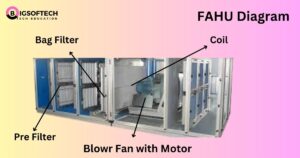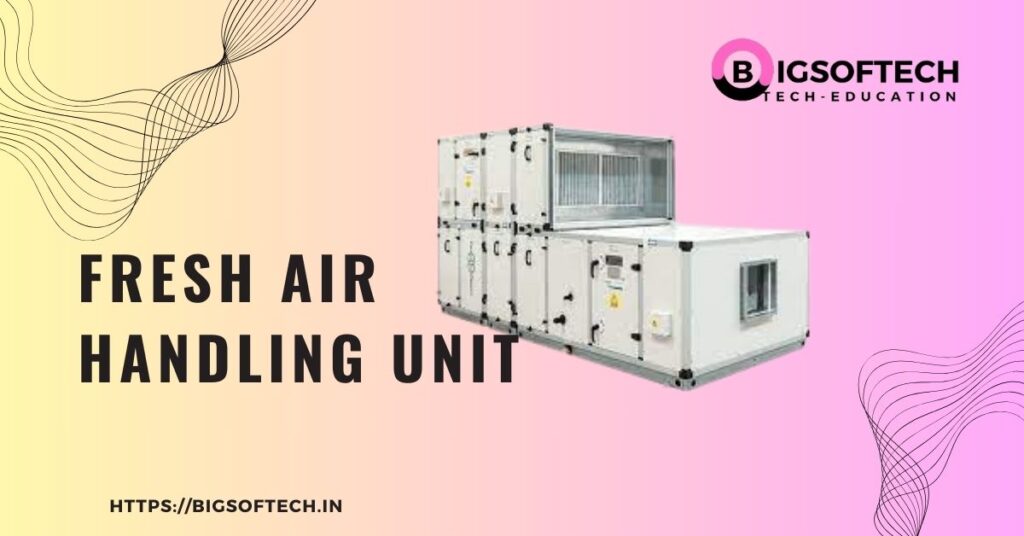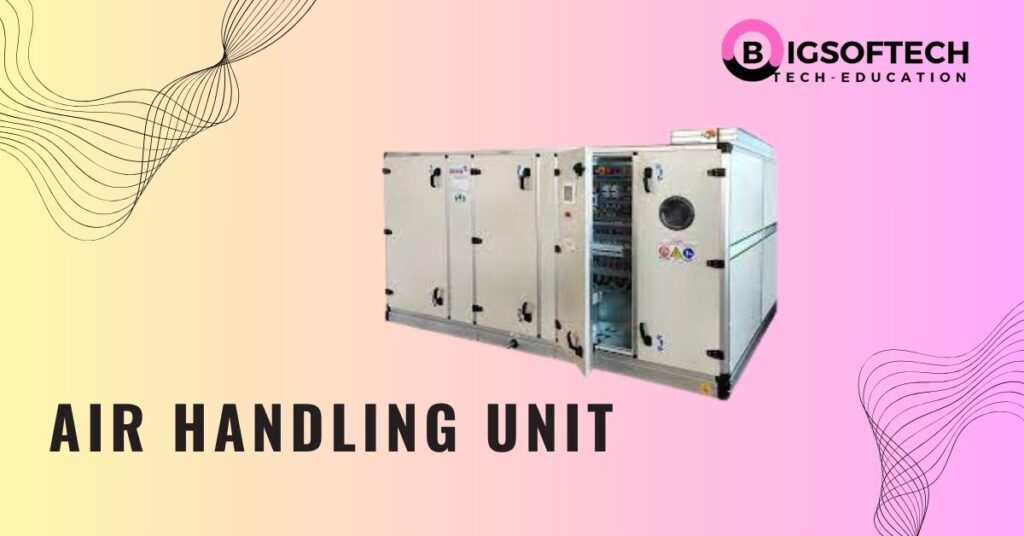The Fresh Air Handling Unit (FAHU) is an invention that is changing the way we control indoor environments. It plays a crucial role in regulating temperature and ventilation indoors. To create healthy and comfortable spaces, it’s important to use devices that actively manage humidity and temperature at ideal levels while improving indoor air quality.
What is FAHU – Fresh Air Handling Unit?
To ensure optimal interior air quality and cultivate a pleasant atmosphere, you require a fresh air handling unit. In this article, we’ll go over the characteristics, benefits, and uses of Fresh Air Handling Unit in detail.
FAHU Working Principles with diagram.

Definition and Acronym Breakdown of Fresh Air Handling Unit
Before we go into our analysis of FAHUs, let’s break down the acronym. FAHUs, or fresh air handling units, are a crucial component of modern ventilation systems.
Components of a Fresh Air Handling Unit
1. Fan
A strong fan is one of the most important parts of any fresh air handling unit that maintains air circulation. The fan pulls in outside air to begin the ventilation process. Its efficiency has a direct impact on the airflow rate, which affects the unit’s overall performance.
2. Heating and Cooling Coils
Temperature control is an essential part of any ventilation system, and fresh air handling units use heating and cooling coils to do this. These coils are positioned within the device in a certain way to regulate the temperature of the entering air. Heating coils that raise the temperature in colder climates and cooling coils that lower it in warmer places provide year-round comfort inside.
3. Filters
A crucial factor is making sure the air being circulated is clean, and filters can assist with that. The purpose of the filters on FAHUs is to gather and remove airborne particles, such as dust, pollen, and other pollutants. This protects the internal components of the device, increases indoor air quality, and extends its lifespan.
(FAHU)Fresh Air Handling Unit Working Principle.
Air Intake and Filtration in Fresh Air Handling Unit
The process begins at the air intake, where the fan draws in fresh air from the surroundings. As air flows via the filters in the filtering system, impurities are collected. This dual-action system ensures that the air entering the interior space is both clean and fresh, which contributes to the creation of a better living or working environment.
Temperature Control in Fresh Air Handling Unit
The temperature is controlled by the air that enters the fresh air handling unit and comes into touch with the heating and cooling coils. To achieve the intended setpoint, these coils control the air temperature. No matter what the outside weather is like, the ability to regulate temperature is essential to maintaining a comfortable environment.
Air Distribution in Fresh Air Handling Unit
When the conditioned air has gone through the necessary treatments, it is then evenly distributed throughout the building. Every section of the room has a sufficient supply of fresh, clean air due to the air distribution system. Continuous circulation is needed to maintain consistent indoor air quality.
7. Control Panel and Automation in Fresh Air Handling Unit
Modern fresh air handling unit typically have automation capabilities and user-friendly control panels. Customers may configure preferences, adjust temperature, control fan speed, and keep an eye on the device’s performance using these interfaces. Automation improves the overall efficacy of FAHUs and provides users with greater interior space control.
FAHU Diagram
Benefits of Fresh Air Handling Unit
Improved Indoor Air Quality
One of the primary benefits of adding an FAHU to a ventilation system is the noticeable increase in interior air quality that follows. Through the continual infusion of outside air, the fresh air handling unit helps to dilute and remove toxins, allergies, and pollutants from the inside.
Energy Efficiency
The design of the Fresh Air Handling Unit prioritizes energy economy and provides a comprehensive and sustainable ventilation solution. The units usually have energy recovery systems installed, which collect and reuse energy from the leaving air. Because of this, FAHUs reduce the system’s overall energy consumption and help save money, making them a sensible choice from an economic and environmental standpoint.
Customization Options in FAHU
One important feature of Fresh Air Handling Units is their versatility, which enables customers to alter the units to meet unique ventilation needs. FAHUs offer an array of customizable functions to meet the individual requirements of various situations, including temperature control, fan speed adjustment, and airflow direction. This customization guarantees that the ventilation system is designed to function at its best in a variety of environments, such as industrial facilities, residential structures, and commercial spaces.
Applications of Fresh Air Handling Unit
Commercial Spaces
Retail Shops
Fresh air handling units are frequently used in retail settings to provide a steady flow of fresh air to create a welcoming and pleasant ambiance for customers. The units satisfy legal criteria for indoor air quality while enhancing the shopping experience.
Office Buildings
Fresh air handling units are essential for preserving a safe and effective work environment in office environments. These units improve general workplace comfort and help employee well-being by continuously supplying fresh, filtered air.
Hotels and Hospitality
FAHUs are essential to the hospitality sector to provide a welcoming atmosphere for visitors. To maintain hygienic standards and provide guests with a comfortable stay, common spaces, lobbies, and guest rooms must have effective ventilation.
FAHU in Residential Buildings
Apartments and Condominiums
To improve indoor air quality, FAHUs are being included in residential buildings more and more. To improve indoor air quality, FAHUs are being included in residential buildings. These units provide a consistent supply of fresh air in both private and common rooms. These units provide a consistent flow of fresh air into individual apartments as well as communal areas, making the living conditions of the occupants healthier. contributing to the inhabitants’ healthier living environment.
Houses for One Family
With FAHUs, homeowners may customize the interior decor of single-family homes. These gadgets offer personalized ventilation choices that are made to fit each family’s particular needs and preferences.
Industrial Facilities
FAHU in Manufacturing Plants
In industrial settings, a fresh air handling unit contributes to a safe and comfortable working environment for employees. During manufacturing processes, they help to reduce the impact of airborne contaminants, manage temperature, and maintain indoor air quality.
Distribution Centers and Warehouses
FAHUs play a critical role in supplying fresh air to large storage facilities and preventing the buildup of stale air. This is necessary to guarantee both the quality of the items being stored and the best possible working conditions for warehouse workers.
FAHU in Medical Facilities and Clinics
In hospital settings, where air quality is vital, FAHUs help maintain sterile conditions. These units enhance staff and patient well-being and speed up patient recovery by preventing the transmission of airborne illnesses.
Fresh Air Handling Unit in laboratories
In research labs, precise control over temperature, humidity, and air quality is crucial. FAHUs are necessary to establish controlled environments that meet the strict requirements of scientific research and testing.
FAHU in Universities and Schools
FAHUs make it easier to create welcoming and accommodating learning environments. They help ensure that teachers and kids have access to fresh air, which creates a healthy and productive learning environment.
Installation Tips For Fresh Air Handling Unit
1. Professional Installation of the Fresh Air Handling Unit.
Select professional installation services wherever possible. Qualified individuals with the knowledge and expertise are responsible for ensuring the correct integration of the FAHU into the existing HVAC system and for installing all components according to manufacturer specifications.
2. Site Assessment
Perform an in-depth site examination before installation. Consider factors such as the availability of space, the positions of intake and exhaust air entry, and the accessibility of electrical connections. This assessment ensures a seamless installation process and helps locate any issues.
3. Proper Ventilation Ducts
Ensure the ventilation ducts are constructed with the proper size and arrangement to fulfill the airflow requirements of the FAHU. Proper installation of the ducting minimizes air resistance and maximizes the performance of the unit.
4. Adequate Space Around the Unit
Allow sufficient room for the FAHU to allow for easy maintenance. This means making sure there is enough room for air intake and exhaust, as well as space for experts to perform routine maintenance and repairs.
5. Compliance with Building Codes
Observe all relevant local building rules and regulations during the installation process. Adherence to regulations guarantees the efficiency and security of the FAHU system and aids in averting any legal and regulatory problems.
6. Electrical Considerations
Make sure that licensed electricians complete the electrical connections. Check that the power source satisfies the needs of the device, and think about adding surge protection to protect the fresh air handling unit from power variations.
7. Testing and Calibration
After installation, do thorough testing and calibration. Examine the unit’s performance under a range of operating conditions to ensure that it meets the specifications for temperature control, filtration efficiency, and airflow rates.
Maintenance Tips For Fresh Air Handling Unit
1. Regular Filter Replacement
Filters need to be replaced often to maintain the highest possible indoor air quality. Use high-efficiency filters for optimal performance, and follow the manufacturer’s recommendations for how often to change your filters.
2. Inspection of Coils and Components
Fans, coils for heating and cooling, and other crucial components should all have regular checks performed to look for wear, corrosion, or debris accumulation. Clean coils as needed to ensure efficient heat exchange and ventilation.
3. Lubrication of Moving Parts
Properly lubricating fan bearings and other moving parts increases component lifespan and reduces friction. Follow the manufacturer’s recommendations for the recommended lubrication intervals and use the recommended lubricants.
4. Cleaning of Air Ducts
Periodically clean the air ducts attached to the FAHU to eliminate dust, mold, and other impurities. In addition to increasing the unit’s efficiency, this keeps pollutants from accumulating in the ventilation system.
5. Inspection of Belts and Drives
Check the belts and drives for wear and tension regularly if the FAHU use them. Wearing-out belts should be replaced as soon as possible to avoid performance problems and lower the chance of unplanned failures.
6. Calibration of Controls
To ensure accurate control over humidity and temperature, calibrate control systems regularly. Check that sensors and actuators are operating properly and adjust as necessary to keep the exact environmental conditions maintained.
7. Professional Maintenance Service of Fresh Air Handling Unit
Make an appointment for expert maintenance services no less than twice a year. Skilled specialists can conduct thorough examinations, identify possible problems, and resolve them before they worsen. Professional maintenance extends the FAHU’s lifespan and improves its overall efficiency.
Conclusion
Finally, FAHUs provide a comprehensive approach to maintaining indoor air quality, acting as an example to advances made in ventilation technology. FAHU efficacy will continue to rise as we embrace the future and integrate smart technologies with sustainable practices.



